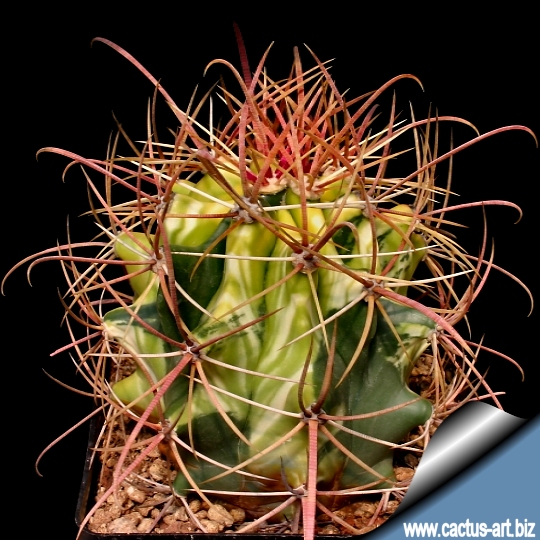|
|
|

Variegations are attractive and
ornamental, and often highly prized.
|
Variegated Ferocactus can be found (although not commonly) in
cultivation, and some of these variegated plants have a place in
any collection. All variegates are
mutants. Something has gone wrong with the cellular structure of the
growth tip (apical
meristem) of the plant. As a result of this mutation,
chlorophyll is missing from some or all layers of the plant
epidermis. The odd variegate appears in many seedling batches in a
small percentage, and is generally separated from normal plants.
Variegated plants grow more slowly, and are generally smaller than
non-variegates of the same species. Coloured areas are also generally
weaker, and more
susceptible to
fungus,
sunburn and other defects. A large well grown variegate Ferocactus
is truly an achievement. These are harder to grow well than they appear.
|
|
 |

|
|
Sun exposition: In the
summer it is best to avoid direct sun during the hottest hours of
the day (but it benefits from morning sun, that helps to produce strong and
colourful spines). In case of cultivation in
full sun it is best to plant with the variegated spot facing
northeast, so it gets the least amount of direct sunlight as possible.
|
 |
 |
F. emoryi x
F. wislizenii
The older variegated part of the stem sometime become crimped.
This is not a defect, but a common characteristic of this type of plant.
|

Ferocactus glaucescens
A lovely variegated seedling |

Ferocactus
diguetii (hybrid)
A white, red and green beauty. |
|


Advertising
|
|
|
|
|
Family:
Cactaceae (Cactus
Family)
Origin:
Garden origin
(Nursery produced cultivars) Usually hybrid.
Conservation status: Listed in
CITES appendix 2.
|
|
|
|

An
hybrid specimen
(F. emoryi x F. wislizenii)
A selected specimen highlighted by dramatic colours, white, lime
yellow and dark green with vivid red spines.

A big F. hystrix variegata

Ferocactus acanthoides hybrid variegata
 |
|